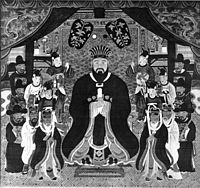- Shō Shin
-
Shō Shin (尚真?)(1465–1526; r. 1477-1526) fue un rey del reino Ryūkyū, el tercero de la linea de la Segunda Dinastía. El prolongado reinado de Shō Shin ha sido denominado "los grandes días de Chūzan", un periodo caracterizado por una gran paz y prosperidad. Era hijo de Shō En, el fundador de la dinastia, por parte de Yosoidon, la segunda esposa de Sho En, a menudo denominada la reina madre. Sucedió a su tío, Shō Sen'i, quien fue obligado a abdicar en su favor.
Gran parte de la organización fundacional de la administración y economía del reino se puede rastrear a los desarrollos que ocurrieron duranto el reinado de Shō Shin. Mientras que el gobierno se hizo más institucionalizado y organizado, los aji (señores locales) gradualmente perdieron poder e independencia, volviéndose más ligados al gobierno central en Shuri. Para fortalecer el control central sobre el reino y para prevenir la insurrección de parte de los aji, Shō Shin reunió las armas de todos los aji para ponerlas al servicio de la defensa del reino, y ordenó a los aji hacer sus residencias en Shuri. Los señores separados de sus tierras y de su gente eran mucho menos capaces de actuar independientemente o de organizar una rebelión y, con el tiempo, sus conexiones emocionales a Shuri crecieron, mientras que aquellas con sus territorios se debilitaban. Las residencias en Shuri de los aji fueron divididas en tres distritos -cada uno para aquellos que venían de las áreas norte, centro y sur de la isla de Okinawa, que previamente habían sido los reinos independientes de Hokuzan, Chūzan y Nanzan respectivamente. Estas regiones fueron ahora renombradas Distrito de Kunigami, Distrito de Nakagami y Distrito de Shimajiri, respectivamente, nombres que siguen usándose hoy en día. A través del matrimonio, la residencia en Shuri y otros factores, los aji llegaron a integrarse más como una clase, asociados más de cerca con la vida, costumbres y política de Shuri, y menos apegados a sus identidades territoriales ancestrales.
Referencias
Bibliografía
- Kerr, George H. (1965). Okinawa, the History of an Island People. Rutland, Vermont: C.E. Tuttle Co. OCLC 39242121
- "Shō Shin." Okinawa rekishi jinmei jiten (沖縄歴史人名事典, "Encyclopedia of People of Okinawan History"). Naha: Okinawa Bunka-sha, 1996. p41.
Categorías:- Wikipedia:Traducciones en desarrollo en inglés
- Monarcas
Wikimedia foundation. 2010.

